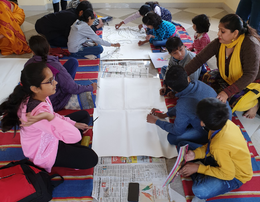Deaf and Hard of Hearing Students: Comprehensive Education Model

Deaf and Hard of Hearing
Special education (school for deaf education) is first and foremost general education for students. Many schools are actively embracing the inclusion model of deaf education, in which all students are educated in the mainstream classroom, regardless of the diversity of their needs.
Students who are deaf and hard of hearing (DHH) have special needs but not they are not due to learning disorders like most other special education populations. The primary difference between students with hearing loss and their classmates is that they do not access speech as fully. Background noise and distance have exaggerated effects on the student with hearing loss as compared to typically hearing peers. Students who are DHH-only have learning gaps and unique needs secondary to access to communication issues, not learning disorders.
Basics of Comprehensive Model:
Inclusion in education is an approach to educating students with special educational needs. Inclusion rejects the use of special schools or classrooms to separate students with disabilities from students without disabilities. Some comprehensive classes use a collaborative team teaching (or co-teaching) model with a special education teacher of the deaf and hard of hearing in the room all day. Other comprehensive classes have special education teachers ‘push in’ at specific times during the day. Both teachers are available to help all students. Studies show that inclusion is beneficial for all students – not just those who receive special education services.
Benefits of the comprehensive model for students with hearing loss:
1. Differentiated Instruction:
All students learn differently. This is a principle of inclusive deaf education. One key teaching strategy is to break students into small groups. By using small groups, teaching can be tailored to the way each student learns best. This is known as differentiated instruction. Teachers meet everyone’s needs by presenting lessons in different ways and using Universal
Design for Learning (UDL). For example, they may use multisensory instruction. In math, that may mean using visual aids and manipulatives like cubes or colored chips to help kids learn new concepts.
2. Supportive Teaching Strategies:
In an inclusive classroom, teachers weave in specially designed instruction and support that can help students make progress. Kids may be given opportunities to move around or use fidgets. And teachers of the deaf often put positive behavioral interventions and supports (PBIS) in place. These strategies are helpful for all students—not only for students with learning and attention issues.
Teaching strategies that support quieter classrooms during communication would be excellent for the student with hearing loss. The fact that inclusive classrooms tend to group students to work together more often than traditional classrooms will result in an overall noisier environment. While some supportive teaching strategies may indeed be good for the student with hearing loss, it can be assumed that some will be detrimental as well.
3. Reduced Stigma:
Inclusive classrooms are filled with diverse learners. That lets kids talk about how everyone learns in their own way. They may find that they have more in common with other kids than they thought. This can go a long way in reducing stigma for kids with learning and attention issues. It can also help kids build and maintain friendships. Diversity in the classroom is a plus for any student with ‘differences.’ Students will naturally come to see themselves as belonging to one or more groups within the classroom setting.
4. Effective Use of Resources:
In more traditional special education settings, many kids are “pulled out” for related services, like speech therapy or for other specialized instruction. An inclusion class often brings speech therapists, reading specialists and other service providers into the classroom. These professionals can provide information and suggestions to help all students.
Increased focus on basic communication skills, vocabulary, syntax, morphology, improving comprehension – all are issues where inclusive settings would be of benefit.
5. High Expectations for All:
Individualized Education Program (IEP) goals should be based on the academic standards for your state. Those standards lay out what all students are expected to learn in math, reading, science and other subjects by the end of the school year.
Differentiated instruction and co-teaching in a general education classroom make it easier for students with standards based IEPs to be taught the same material as their classmates. In some schools, only certain classrooms are inclusion classes. In that case, schools may assign general education students randomly to inclusive or non-inclusive classes. Other schools may choose students who benefit from the emphasis on meeting the needs of all learners at all ability levels.
Common core standards based IEPs strongly support development of skills that result in full participation in the classroom, and therefore have a positive influence on the education of students with hearing loss.
Summary
The inclusion model of special education has been adopted by many school districts in other countries. We hope to see it in India soon. The positives of having a diverse learning community, implementing differentiated learning, varied teaching strategies, and universal design for learning principles are all beneficial aspects of the inclusion model.
Suniye is an educational NGO in Delhi, provides educational programs for hearing impaired students and guarantees all children from preschool to third class will certainly have the ability to go to college, play, engage, and discover new things with other kids of their age. We teach speech & language therapy to hearing impaired children. We have taught over 1,000+ hearing impaired students over the last 25 years.

